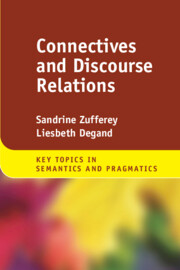Book contents
- Connectives and Discourse Relations
- Key Topics in Semantics and Pragmatics
- Connectives and Discourse Relations
- Copyright page
- Contents
- Figures
- Tables
- 1 Defining Connectives and Discourse Relations
- 2 Theoretical Models of Discourse Relations
- 3 Connectives: Meanings and Functions
- 4 Connectives between Syntax and Discourse
- 5 The Evolution of Connectives’ Meanings
- 6 Processing and Understanding Discourse Relations and Connectives
- 7 Discourse Relations and Connectives across Languages and Genres
- 8 Acquiring Connectives in a First Language
- 9 Mastering Connectives in a Second Language
- Conclusion
- Glossary
- References
- Index
- References
3 - Connectives: Meanings and Functions
Published online by Cambridge University Press: 22 February 2024
- Connectives and Discourse Relations
- Key Topics in Semantics and Pragmatics
- Connectives and Discourse Relations
- Copyright page
- Contents
- Figures
- Tables
- 1 Defining Connectives and Discourse Relations
- 2 Theoretical Models of Discourse Relations
- 3 Connectives: Meanings and Functions
- 4 Connectives between Syntax and Discourse
- 5 The Evolution of Connectives’ Meanings
- 6 Processing and Understanding Discourse Relations and Connectives
- 7 Discourse Relations and Connectives across Languages and Genres
- 8 Acquiring Connectives in a First Language
- 9 Mastering Connectives in a Second Language
- Conclusion
- Glossary
- References
- Index
- References
Summary
This chapter first considers the functional and semantic overlap between discourse connectives and discourse markers, where the latter is presented as including the former. Since the two categories share most protypical features, the fuzzy boundaries between the two categories are explained in terms of partial overlap.
We then show that the description of connectives’ meanings and functions can proceed following an onomasiological as well as a semasiological approach. The latter has given rise to numerous case studies in a variety of languages aiming to come to a fine-grained semantic description of specific connectives. Strenghts and weaknesses of such studies are presented. Onomasiological approaches focus on a set connectives that are categorized together on the basis of shared semantic properties, trying to disentangle their similarities and differences, within and across languages. In the final section, we turn to one of the most described features of discourse connectives namely its polysemy and polyfunctionality, and how contextual cues may help solve this ambiguity, and how polysemy is a key explaining factor in the (frequency) distribution of connectives.
Keywords
- Type
- Chapter
- Information
- Connectives and Discourse Relations , pp. 48 - 71Publisher: Cambridge University PressPrint publication year: 2024

